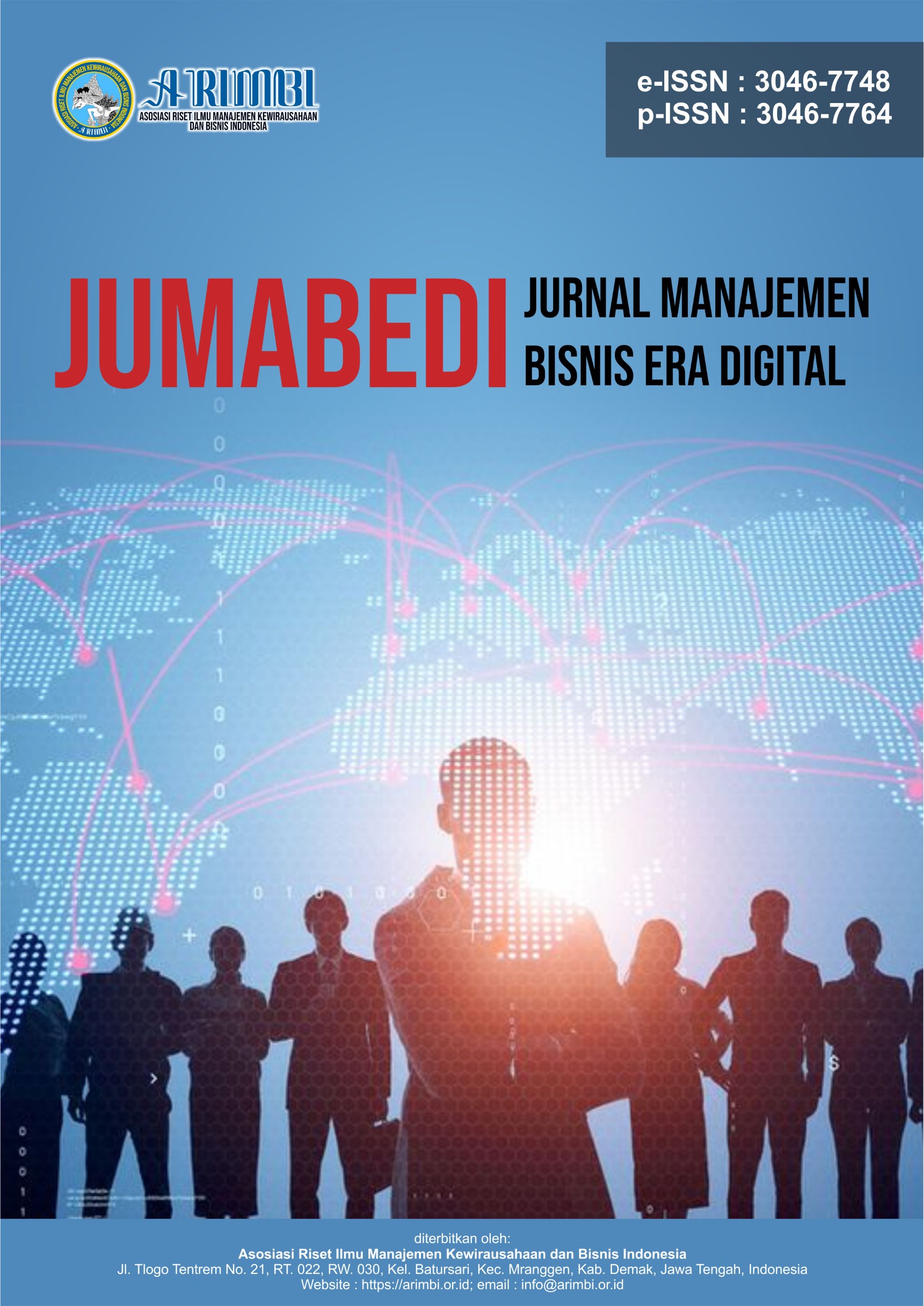Pengaruh Inovatif Work Behavior terhadap Kinerja Karyawan dengan Keterlibatan Kerja Sebagai Variabel Mediasi
Studi pada Badan Penanggulangan Bencana Daerah Kota Batu
DOI:
https://doi.org/10.61132/jumabedi.v2i3.689Keywords:
Digital Era, Disaster management, Employee Performance, Innovative Work Behavior, Work InvolvementAbstract
In the rapidly changing digital and global era, organizations are required to be adaptive and innovative to survive and compete sustainably. Employee performance is one of the strategic factors in supporting organizational success. This research is motivated by the urgency of improving performance through innovative work behavior (IWB) and work engagement, which are considered two key elements in addressing the challenges of modern organizations. The main objective of this study is to analyze the effect of IWB on employee performance and evaluate the mediating role of work engagement in this relationship. This study uses a quantitative approach with the Structural Equation Modeling Partial Least Square (SEM-PLS) method, and was conducted on employees of the Batu City Regional Disaster Management Agency (BPBD). The results of the analysis indicate that IWB has a positive and significant influence on work engagement and employee performance. In addition, work engagement is also proven to act as a partial mediator that strengthens the relationship between IWB and performance. This means that the higher the innovative behavior of employees, the higher their engagement in work, which ultimately has a positive impact on performance improvement. These findings enrich the theoretical literature, particularly supporting theoretical frameworks such as Social Exchange Theory, Self-Determination Theory, Job Demands-Resources Model, and Conservation of Resources Theory. Practical implications of this research suggest that organizations need to create a work environment that supports innovative behavior and enhances employee work engagement by providing autonomy, recognition, and opportunities for self-development. This research suggests further studies to explore other contextual factors, such as organizational culture, transformational leadership, and supervisor support, which have the potential to strengthen the relationship between IWB, work engagement, and employee performance in various organizational sectors.
Downloads
References
Ardiansyah, S. A., & Utami, D. R. N. (2019). Uji Aktivitas Penurunan Indeks Obesitas Dari Ekstrak Etanol Biji Kopi Hijau Robusta (Coffea canephora) Terhadap Tikus Putih Jantan Galur Wistar. Jurnal Sains dan Teknologi Farmasi Indonesia, 8(2).
Ardilla, A., Anggreini, K. W., & Rahmani, D. P. (2022). Peran bakteri asam laktat indigen genus Lactobacillus pada fermentasi buah durian (Durio zibethinus) untuk produksi tempoyak. Jurnal Bioteknologi dan Industri Pertanian, 13(1), 42-52. https://doi.org/10.22146/bib.v13i2.4619
Asih, E. H. (2020). Isolasi dan identifikasi pada kopi robusta (Coffea canephora) dari daerah Jatinegara Kabupaten Tegal. Karya Tulis Ilmiah. Program Studi DIII Farmasi Politeknik Harapan Bersama Tegal.
Asrianto, A., Asrori, A., Sahli, I. T., Hartati, R., & Kurniawan, F. B. (2020). Bioaktivitas ekstrak etanol biji pinang terhadap Staphylococcus aureus dan Escherichia coli. Jurnal Sains dan Kesehatan, 3(6). https://doi.org/10.25026/jsk.v3i6.702
Bakker, A. B., & Demerouti, E. (2007). The Job Demands‐Resources model: State of the art. Journal of Managerial Psychology, 22(3), 309–328. https://doi.org/10.1108/02683940710733115
Blau, P. M. (1964). Exchange and power in social life. New York, NY: Wiley.
Boyne, G. A. (2002). Public and private management: What’s the difference? Journal of Management Studies, 39(1), 97–122. https://doi.org/10.1111/1467-6486.00284
Budiyanto, B., Uker, D., & Izahar, T. (2021). Karakteristik fisik kualitas biji kopi dan kualitas kopi bubuk sintaro 2 dan sintaro 3 dengan berbagai tingkat sangrai. Jurnal Agroindustri, 11(1), 54-71.
Deci, E. L., & Ryan, R. M. (2000). The "what" and "why" of goal pursuits: Human needs and the self-determination of behavior. Psychological Inquiry, 11(4), 227–268. https://doi.org/10.1207/S15327965PLI1104_01
Emilda, & Delvira, N. (2023). Pemanfaatan silika gel 70–230 mesh bekas sebagai pengganti fase diam kromatografi kolom pada praktikum kimia organik. Indonesian Journal of Laboratory, 6(1), 45-51.
Fairish, N., Amelia, A., Putri, D., Afriliany, S., Kamilah, S., & Fikayuniar, L. (2023). Perbandingan Hasil Skrining Fitokimia dari Metode Tabung, TLC (Thin Layer Chromatography) dan Penetapan Kadar Sari dalam Bijian Kopi Hijau. Jurnal Ilmiah Wahana Pendidikan, 9(16), 115-124. https://doi.org/10.5281/zenodo.8232358
Firmansyah, B. T., Setiawan, A., & Santoso, D. (2024). Karakterisasi morfologi kopi arabika (Coffea arabica L.) di kawasan Desa Sempol Kecamatan Ijen Kabupaten Bondowoso. Agropross, National Conference Proceedings of Agriculture. https://doi.org/[tambahkan jika ada DOI]
Haikal, M., Yusuf, A., & Andriani, R. (2024). Tingkat kesukaan konsumen terhadap teh daun kopi arabika (Coffea arabika L.). Jurnal Ilmiah Mahasiswa Pertanian, 9(1).
Haryanto, R., & Riyanto. (2023). Pengaruh lama penyimpanan ekstrak terhadap kadar pinostrobin dalam ekstrak etanol temukunci (Kaemferia pandurata, Roxb). Prosiding Seminar Nasional Hasil Penelitian dan Pengabdian Masyarakat.
Kartasasmita, R. E., & Addyantina, S. (2012). Dekafeinasi biji kopi robusta (Coffea canephora L.) menggunakan pelarut polar (etanol dan metanol). Acta Pharmaceutica Indonesia, 37(3), 83-89.
Messmann, G., & Mulder, R. H. (2012). Development of a measurement instrument for innovative work behaviour as a dynamic and context-bound construct. Human Resource Development International, 15(1), 43–59. https://doi.org/10.1080/13678868.2011.646894
Downloads
Published
Issue
Section
License
Copyright (c) 2025 Jurnal Manajemen Bisnis Era Digital

This work is licensed under a Creative Commons Attribution-ShareAlike 4.0 International License.





